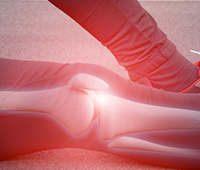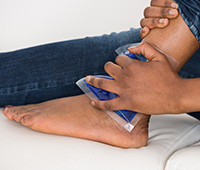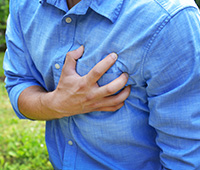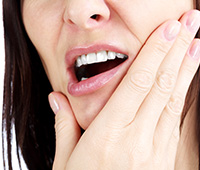WHAT IS Joint Pain
- Definition
- Causes
- Symptoms
- Diagnosis
- Ayurvedic Tips
- FAQS
- References
Definition

Joint pain can be any kind of discomfort, pain or swelling arising from any part of a joint - including cartilage, bone, ligaments, tendons or muscles. A joint is the area where two bones meet. Most commonly, joint pain refers to a condition named as arthritis, which is swelling or pain from within the joint itself.1 There are more than 100 different types of arthritis. Most common type of arthritis affecting joints is osteoarthritis.2

Ayurveda describes joint pain as 'Sandhivata', which is similar to the condition of osteoarthritis, in which the vitiated vata affects the joints, which leads to a painful swelling and destruction of the joints. Injury, ama (undigested toxin), excessive fasting, riding or standing worsens vata dosha which leads to Sandhivata.3
Disclaimer: The information on this page is not intended to be a substitute for professional medical advice. Do not use this information to diagnose or ayurvedic treatment of pain and/or joint pain without consulting the doctor. Consult your physician before beginning an exercise regime. "While we have products /ayurvedic medicines for pain and/or joint pain, you must consult an authorized physician before taking any of the products. For more information on products, visit www.dabur.com or call 1800-103-1644"
Causes
Causes OF Joint Pain
Arthritis involves the breakdown of cartilage. Cartilage is a type of connective tissue which joins two bones together to form a joint.2 Normal cartilage protects a joint and allows it to move smoothly. Cartilage also acts like a buffer and absorbs shock when pressure is placed on the joint, such as when you walk. Without the normal level of cartilage, the bones rub together. This causes swelling and stiffness.2
Apart from arthritis, joint swelling and damage may result from other causes such as:2
- Rheumatoid arthritis: Body's immune system attacks healthy joints out of malfunction
- Broken bone
- General "wear and tear" in joints
- Infection of joints
- Crystals such as uric acid accumulating in joints to develop a condition named gout
In India, around 30% women aged between 45 to 60 years and 68% women aged above 68 years have osteoarthritis.3 The cause of Sandhivata in Ayurveda is linked to improper diet, life style and old age, causing degeneration of body elements (dhatu kshaya), worsening of Vata; the humor responsible for all the movements and functions of the body and reduction in Shleshaka Kapha - fluid in the joints. The aggravated Vata brings rukshyata (dryness), laghutva (lightness or porousness), kharatva (coarseness) in the joints causing degeneration.4
Disclaimer: The information on this page is not intended to be a substitute for professional medical advice. Do not use this information to diagnose or ayurvedic treatment of pain and/or joint pain without consulting the doctor. Consult your physician before beginning an exercise regime. "While we have products /ayurvedic medicines for pain and/or joint pain, you must consult an authorized physician before taking any of the products. For more information on products, visit www.dabur.com or call 1800-103-1644"
Symptoms
Symptoms OF Joint Pain
Common symptoms of arthritis include:
- Joint pain
- Joint swelling
- Limited movement of the joint
- Redness and warmth of the skin around a joint
- Joint stiffness, in the morning or after long intervals of inactivity
- Cracking of joints on moving
Disclaimer: The information on this page is not intended to be a substitute for professional medical advice. Do not use this information to diagnose or ayurvedic treatment of pain and/or joint pain without consulting the doctor. Consult your physician before beginning an exercise regime. "While we have products /ayurvedic medicines for pain and/or joint pain, you must consult an authorized physician before taking any of the products. For more information on products, visit www.dabur.com or call 1800-103-1644"
Diagnosis
Diagnosis OF Joint Pain
Physical exam: A thorough physical exam and medical history helps the doctor to understand the cause of joint pain or the type of arthritis that may have developed. The physical exam may show:
- Fluid around a joint
- Warm, red, tender joints
- Difficulty moving a joint
- Some types of arthritis may cause joint deformation. This may be a sign of severe, untreated rheumatoid arthritis.
Blood tests & Imaging tests: Blood tests and joint X-rays are often done to check for infection and other causes of arthritis.
Biopsy: The doctor may also remove a sample of joint fluid with a needle and send it to a lab to be checked.
Disclaimer: The information on this page is not intended to be a substitute for professional medical advice. Do not use this information to diagnose or ayurvedic treatment of pain and/or joint pain without consulting the doctor. Consult your physician before beginning an exercise regime. "While we have products /ayurvedic medicines for pain and/or joint pain, you must consult an authorized physician before taking any of the products. For more information on products, visit www.dabur.com or call 1800-103-1644"
Ayurvedic Tips
Ayurvedic Tips Joint Pain
Ayurveda can play a significant role in managing joint pain by practising a combination of corrective Ahar (diet), Vihaar (exercise) and Aushadhi (medicines)3,5
Diet Recommendations (Aahar)
- Grains: Rice, wheat, barley
- Pulses: Black gram, green gram,
- Vegetables: Onion, garlic, sesame seeds, ginger, radish, ladies finger, pumpkin
- Fruits: Pomegranate, mango, grapes
- Oils: Ghee
Lifestyle changes (Vihar)
Exercise, yoga and meditation can have a profound healing effect on the swelling of joints by activating the healing energies within the joints. Some yogic exercises are very beneficial, while some are not advised in severe joint pain. Some of the most beneficial asanas and exercises are:
- Pranayama: Nadi shodhana, deep abdominal breathing, bhramari, kapalbhati
- Yogasanas: Pawanmuktasana, Makarasana, Dhanurasana, Vakrasana
- Other yogic practices: Yoga nidra, meditation, Janu chakra, Manibandha chakra






Disclaimer: The information on this page is not intended to be a substitute for professional medical advice. Do not use this information to diagnose or ayurvedic treatment of pain and/or joint pain without consulting the doctor. Consult your physician before beginning an exercise regime. "While we have products /ayurvedic medicines for pain and/or joint pain, you must consult an authorized physician before taking any of the products. For more information on products, visit www.dabur.com or call 1800-103-1644"
FAQS
FAQS
1. Can Ayurveda treat foot pain?
In Ayurveda, foot care is considered very important since it is known to benefit the entire body and nervous system in a holistic manner. There are certain points in our body called marma or vital points, where our vital energies are concentrated. Feet and ankles also have these vital points, which if not taken care of, can cause problems like chronic pain in the ankles, pain and swelling in feet, etc. Ayurveda can play a significant role in managing ankle pain with a combination of corrective Ahar (diet), Vihar (exercise) and Aushadhi (Medicines) regime.
2. What kind of diet and exercises will be helpful in reducing neck pain?
To reduce neck pain, Ayurveda suggests following diet and exercises:
- Take lots of fruits, green vegetable salads and sprouts.
- Good hydration will help retain neck health.
- Avoid refined foods and junk foods.
- Milk is an important source of Calcium and can help maintain healthy bones.
- Vitamin C in citrus fruits will help the healing process.
- Honey in warm water or herbal teas are good for cleansing the bowels and this will help relieve many backaches that are due to constipation.
Pranayama (breathing exercises) is a powerful way to promote relaxation and a pivotal first step towards relieving muscle tension. Slow, deep breathing & relaxation can stimulate a sense of calmness and cause reduction in pain.
Yoga Asanas are also beneficial in maintaining neck and overall health
- Balasana
- Marjaryasana
- Bhujangasana
3. I have knee pain. What could be the reasons for it?
Knee pain can have different causes. Being overweight puts you at greater risk for knee problems. Overusing your knee can trigger knee problems that cause pain. If you have a history of arthritis (swelling of knee joint), it could also cause knee pain.
Medical conditions that can cause knee pain are
- Arthritis – Rheumatoid arthritis, Osteoarthritis, Gout
- Infection in the knees / knee joint
- Injuries – fracture, dislocation, sprained knees etc.
- Cancer
4. What can I do to reduce my knee pain?
Ayurveda suggests following diet and lifestyle changes to help reduce knee pain.
Include more foods containing
- Pulses: Black gram, green gram
- Vegetables & spices: Onion, garlic, sesame seeds, ginger, radish, ladies finger, pumpkin
- Fruits: pomegranate, mango, grapes
- Oils: Ghee
Ayurveda recommends regular, slow and gentle exercises with adequate rest to knee joints. Regular Pranayama and Yoga Nidra is also recommended.
- Avoid prolonged walking, standing, kneeling and squatting and crossed leg sitting.
- Yoga asanas: Makarasana, Pavanamuktasana, Dhanurasana, Vakrasana
5. I have tingling pain in the legs. Is it sciatica?
Sciatic pain most often occurs on one side of leg or hip. Symptoms of sciatica pain can vary widely as mentioned below:
- Mild tingling
- Dull aching that radiates from buttock to back of whole leg
- Burning sensation
- Inability to move leg when pain becomes severe
The pain often starts slowly and may get worse:
- After standing or sitting
- At night
- When sneezing, coughing, or laughing
6. What diet is effective in reducing the sciatica pain?
A healthy diet for controlling sciatica pain is for balancing Vata dosha and includes:
- Grains: Rice, cooked oatmeal, whole wheat and whole grain breads (toasted)
- Pulses: Yellow split mung beans (green skin removed), whole mung beans, red lentils and tofu
- Vegetables: : Zucchini, asparagus, carrot, beets, sweet potatoes, cucumber, lady finger, parsley, green peas, fennel, spinach in small amounts and cooked coconut. All should be cooked well so they are soft.
- Spices: Cumin, ginger, mustard seeds, ajwain, celery seeds, fenugreek, coriander, bay leaves, basil, saffron, hing (asafoetida), cinnamon, cardamom, cloves, anise, fennel, black pepper (in small amounts)
- Fruits: All ripe, sweet, and juicy fruits. Sweet grapes, banana, melons, plums, cherries, mango, papaya, pomegranate, sweet pineapples, raisins, sweet oranges, dates and figs, avocado, apples and pears.
- Oils: Ghee or organic olive oil
- Sweeteners: Honey, jaggery, date sugar
7. I frequently get gas pain. What food types are good for me?
Following foods are good to help relieve gas pain:
- Grains: Whole wheat thick flat bread or chapati, millet & sorghum bhakri, unpolished rice
- Pulses: Chickpea, Tur dal, Masoor Moong
- Vegetables: Carrots, Radish, Lauki, potatoes, white gourd, spiny gourd, , cucumber, ajwain, guar bean, eggplant, amaranth, cabbage, spinach, coriander seeds and leaves, sweet potatoes, tomatoes, green chillies, lady finger
- Fruits: , pears, papaya, pineapple, pomegranate, oranges, unripe bananas, water chestnut, dry fruits – almonds, walnuts, peanuts, dry dates, apples, grapes etc.
- Oils: Ghee, coconut oil in small quantities
- Ginger, cumin, coriander should be preffered in spices.
8. What is trigeminal neuralgia?
Trigeminal nerve (TN) pain is a nerve condition that causes a stabbing or electric-shock-like pain in parts of the face.
It usually affects one side of the face. Any vibration on your face, even from talking, brushing etc. can set it off. The condition may come and go, disappearing for days or even months. But the longer you have it, the less often it goes away. TN pain usually affects women and people above 50 years of age.
Ayurveda describes 11 types of shiro rogas (headaches), among which trigeminal nerve type of pain is called ‘Ardhavabhedaka’. It happens when aggravated doshas (Vata, Pitta and Kapha) press on the neck and throat producing a powerful burning sensation, out of which comes excruciating pain. This pain ultimately affects the eyes, eyebrows and temples.
9. How can Ayurveda help in relieving stomach pain?
Ayurveda describes a comprehensive approach towards managing stomach pain- the most commonly diagnosed conditions being constipation (Vibandha) and indigestion (Ajirna)
Constipation is used to indicate fewer bowel movements, hard stools, painful defection and feeling of bloating, abdominal pain or incomplete elimination.
Indigestion, on the other hand, is an abnormality that occurs in digesting food or lack of proper digestion resulting in stomach pain, burping or flatulance (abdominal gas).
Ayurveda can play a significant role in managing & preventing different stomach pains by practising a combination of corrective Ahar (diet), Vihar (exercise) and Aushadhi (Medicines) regime
Corrective Ahar for both constipation & indigestion includes:
Grains: Wheat, unpolished rice, barley
- Pulses: Green gram, chickpeas, course corn, Toor dal, moong, masura lentils, Vegetables/Spices: Garlic, Asafetida, long pepper, sunthi (dry ginger), green leafy vegetables, cucumber, bitter gourd, pointed gourd, cabbage, dates, betel nut, turmeric
- Fruits: High fibre fruits such as apples, pears, papaya, grapes, amala, haritaki
- Oils: Ghee
Exercise: Regular exercise, meditation and practice of asanas purifies the blood, improves the appetite, increases the will power and makes the patient physically active. The whole alimentary canal improves and becomes regular.
Yoga Asanas: Vajrasana (after every meal), Kurmasana, Vakrasana, Katichakrasana
Pranayama: Surya anulom viloma, deep relaxation technique
10. What is myofasial pain?
Myofascial pain disorder (MPS) refers to pain and swelling in the body's soft tissues or muscles. Myofascial pain is a long-term, painful condition that affects the connective tissue that cover the muscles. It is considered as a type of muscular pain (fibromyalgia) which happens at specific areas on the body.
Myofascial pain might involve either a single muscle or an entire muscle group. In some cases, the area where you experience the pain might not be where the myofascial pain is generated. The actual location of the injury leads to the development of a trigger point, which in turn causes pain in other areas. This is known as referred pain
Disclaimer: The information on this page is not intended to be a substitute for professional medical advice. Do not use this information to diagnose or ayurvedic treatment of pain and/or joint pain without consulting the doctor. Consult your physician before beginning an exercise regime. "While we have products /ayurvedic medicines for pain and/or joint pain, you must consult an authorized physician before taking any of the products. For more information on products, visit www.dabur.com or call 1800-103-1644"
References
References
- Arthritis. MedLine Plus. [Cited 2016 September 5]. Available at: https://medlineplus.gov/ency/article/001243.htm
- Srikanth N. Ayurvedic Management of Select Geriatric Disease Condition. CCRAS New Delhi. 2011.
- Srinivas P, et al. ASSESSMENT OF DIETARY PRACTICE AMONG OSTEOARTHRITIS PATIENTS. Int J Pharm Pharm Sci, Vol 6, Issue 6, 578-581.
- Saraswati SS. Asana pranayama mudra bandha. 2009 Jan 1.
Disclaimer: The information on this page is not intended to be a substitute for professional medical advice. Do not use this information to diagnose or ayurvedic treatment of pain and/or joint pain without consulting the doctor. Consult your physician before beginning an exercise regime. "While we have products /ayurvedic medicines for pain and/or joint pain, you must consult an authorized physician before taking any of the products. For more information on products, visit www.dabur.com or call 1800-103-1644"




